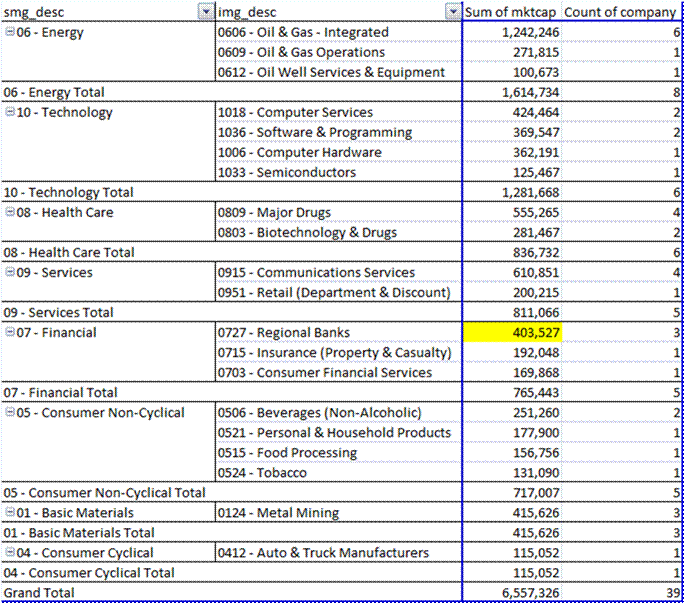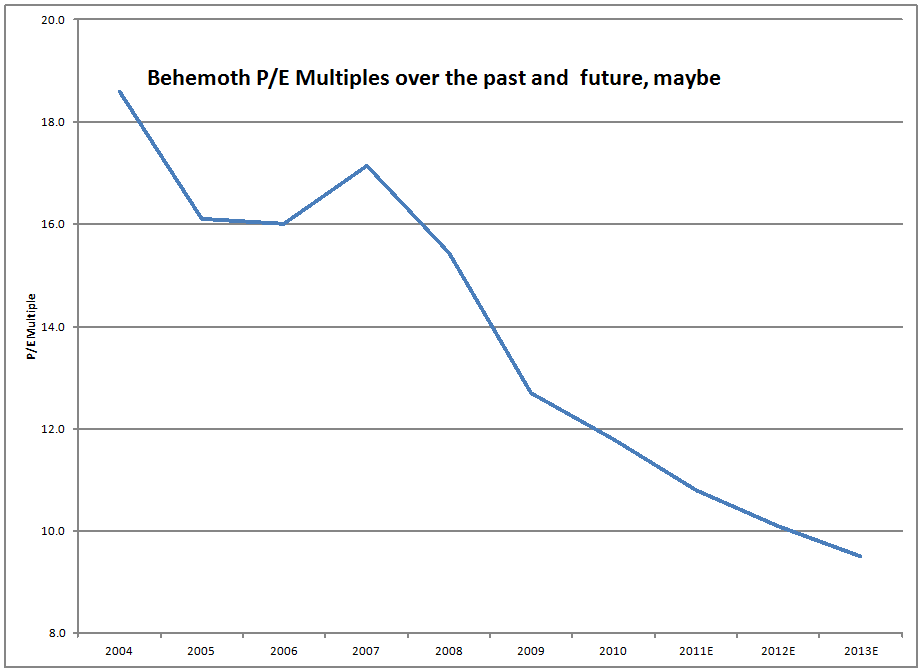Return to Behemoth Stocks
Somewhat less than three years ago, I wrote two articles on Behemoth stocks [one, two], which I define as stocks with over $100 Billion of market cap. ?Today I want to revisit those stocks, and those that have joined them. ?The last time I wrote, there were 39 of them actively trading on US Exchanges. ?Now there are 61, for a difference of 22. ?24 stocks are new, and two?have dropped out. ?Let start with those two:
- Vodapone plc [VOD] sold off its interest in Verizon Wireless to Verizon, creating a lot of value, and returned a lot of capital to shareholders. ?For those of us who were shareholders, I can only say, great job. ?You made Verizon pay up, and you didn’t blow all of the new free capital on suboptimal projects.
- The stock price of Vale, SA [VALE] has gone down considerably (~40%). ?
China is no longer a giant vacuum cleaner for mineralsThe pace of China’s expansion has slowed, and that has had an impact on base metals producers like Vale.
This highlights three things:
- In a bull market, once you are big, you tend to stay there.
- If you want to create value for shareholders as a behemoth, you need to take radical actions that sell off parts of the company, and return capital to shareholders. ?Managements should think, “How can we reorganize the company such that each component part will be better managed, and lines that we aren’t so good at are sold off.”
- In general, these companies are too large to be taken over; change must come from within. ?Activists will only succeed if the managements let them.
Now let’s look at the new companies, which fall into six main groups: Consumer Oriented, Banks,?Pharmaceuticals,?Information Technology,??Industrials, and??Internet.
Consumer Oriented
- Anheuser Busch Inbev SA (ADR) [BUD]
- British American Tobacco PLC [BTI]
- Comcast Corporation [CMCSA]
- Home Depot, Inc. [HD]
- Visa Inc [V]
- Walt Disney Company [DIS]
Banks
- Banco Santander, S.A. (ADR) [SAN]
- Bank of America Corp [BAC]
- Citigroup Inc [C]
- Royal Bank of Canada [RY]
- Westpac Banking Corp (ADR) [WBK]
Pharmaceuticals
- Amgen, Inc. [AMGN]
- Bayer AG (ADR) [BAYRY]
- Gilead Sciences, Inc. [GILD]
- Sanofi SA (ADR) [SNY]
Information Technology
- Cisco Systems, Inc. [CSCO]
- QUALCOMM, Inc. [QCOM]
- Taiwan Semiconductor Mfg. Co. [TSM]
Industrials
- Siemens AG (ADR) [SIEGY]
- United Technologies Corp [UTX]
- Volkswagen AG (ADR) [VLKAY]
?Internet
- Amazon.com, Inc. [AMZN]
- Facebook Inc [FB]
?Energy
- China Petroleum & Chemical Corp [SNP]
Most of these stocks have become Behemoths as a result of rising earnings and expanding P/E multiples amid the bull market. ?A few, like Facebook and Amazon don’t require much in the way of earnings to support their stock price versus something like an Apple or a Google. ?But let me show you my summary graph regarding now and three years ago for Behemoth stocks:
Three years ago, 2011-13 earnings were estimated, versus 2014-16 earnings today. ?If you look at 2008-10, you can see the impact of the new stocks on the median P/E of the group as a whole. ?In general, the P/Es of the new Behemoth stocks were higher than those that were already Behemoths three years ago, pulling the median at least one multiple turn higher.
And looking at 2011-13 estimated versus the actual, you can see how much valuations have increased over that period. ?It didn’t happen all at once, but the S&P 500 is ~60% higher now than when I wrote the first two pieces (not counting dividends).
In December 2011 you could consider getting 9-10% earnings yields out of the Behemoths. ?Today, you’re looking at 7%. ?Quite a difference. ?Some of it could be attributed to tighter yield spreads, but not to changes in Treasury yields, which are actually higher now than they were in December 2011.
You aren’t as well-compensated today relative?to BBB corporate yields to play in the Behemoth stocks today. ?Now, the Behemoths may be safer than many other stocks in the market, and are priced at a discount to the market averages, but your absolute margin of safety is lower.
What Can Behemoth Stocks do for You?
- They can pay you dividends. ?They have relatively protected market niches, and they pay above average dividends — 2.9% on average, and that is with seven that have dividends of less than 1%.
- They can go down less than other stocks whenever the next bear market?hits.
What Can’t Behemoth Stocks do for You?
- They can’t grow as rapidly as smaller companies.
- They can’t be taken over, so improvements from entrenched management teams must come from sweet reason convincing them, rather than barbarians at the gates.
What Could Behemoth Stocks do for You, if Management Teams were Willing to Take Some Chances?
These ideas aren’t likely, because those that manage Behemoth companies like managing these monstrosities, but if they did consider shareholders first:
- Energy companies would split into upstream, midstream, refining?and retail companies.
- Conglomerates would divide into more focused companies.
- Large financial companies would split into companies focused on serving specific markets, realizing that there are few advantages from diversification, and much loss from lack of focus.
- Companies would segment into slow-growing legacy businesses which can be reliable income vehicles, and the rapidly-growing portions that could be amazing with some focus.
- Frito-Lay would spin off Pepsi.
- Procter and Gamble and GE would be even more aggressive about spinning off entities.
The main problem with Behemoths is that they are undermanaged. ?There is only so much a single senior management team can do; the incentives of management teams get rather dull with respect to each division. ?Even the radical decentralization of Berkshire Hathaway can only do so much; a day will come when they will centralize, reorganize and prune, but not while Warren Buffett still leads.
As for me and my clients, we own six of the cheaper Behemoth stocks, comprising ?14% of our holdings, biding our time until I?see better opportunities.
Full Disclosure: Long BRK/B, BP, CVX, SNP, TOT, and WFC









